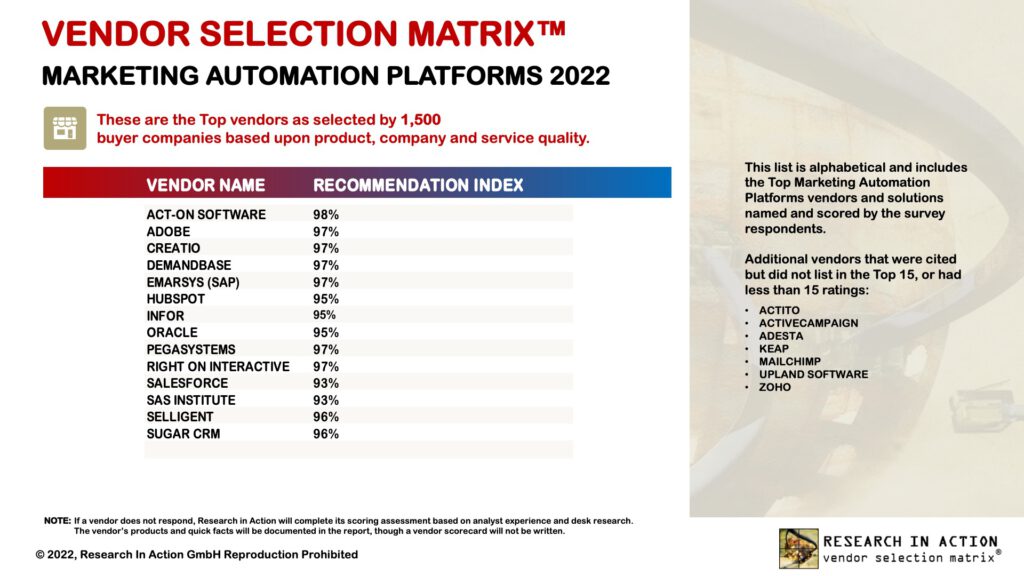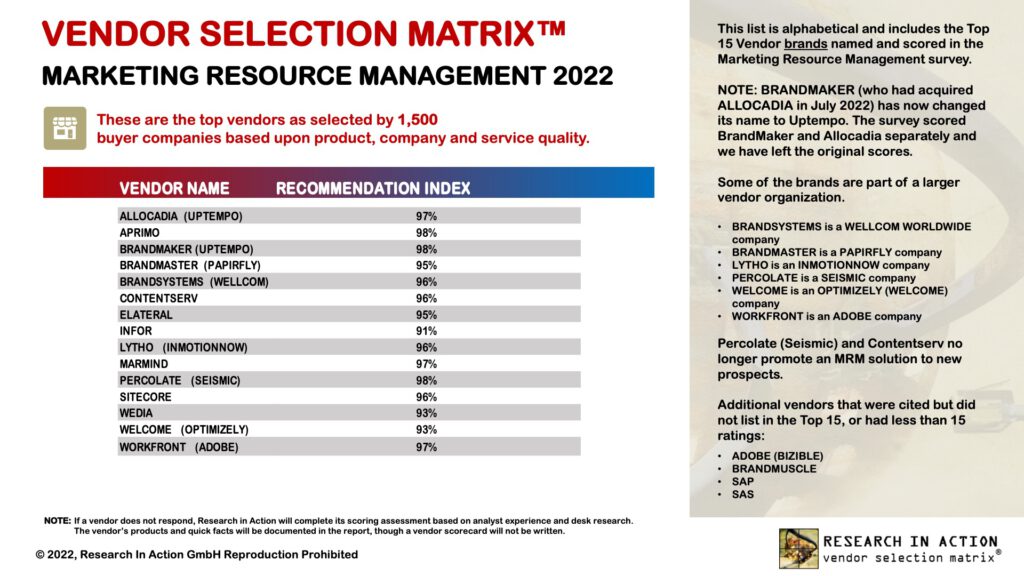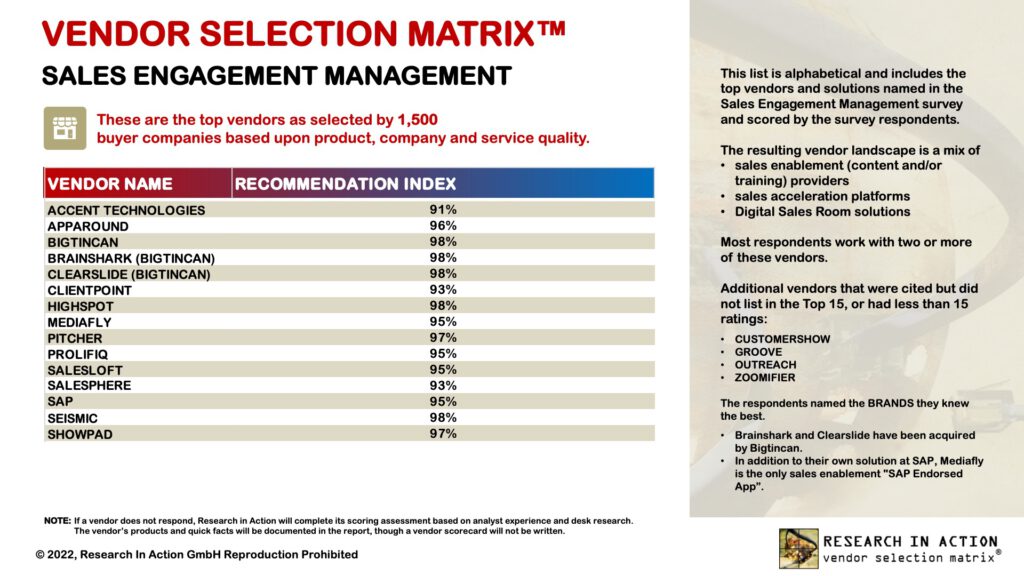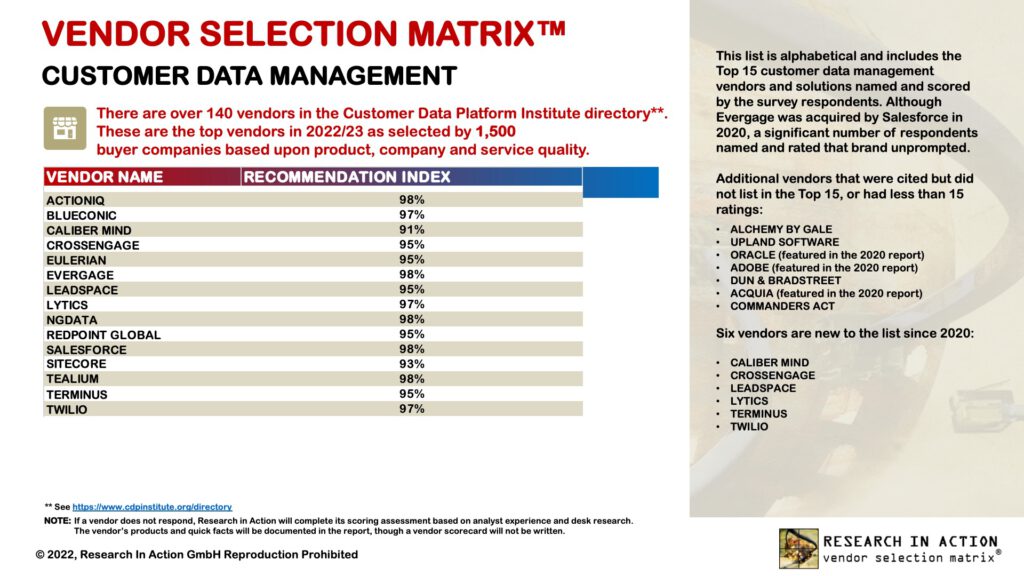-
Propensity to Switch Vendors
This year, I have collected several new Recommendation Index (RI) values from the Vendor Selection MatrixTM reports we have published. I see the RI as a significant leading indicator of long-term customer satisfaction but also, more importantly, of the propensity to switch indicated by customers. It is for that reason that we have included the points earned through the RI score in our Strategy axis on the matrix and give it a significant 25% weighting.
In our surveys, we actually ask about two items directly related to customer retention: the current satisfaction, and the “would you recommend this vendor?” question. Customer satisfaction is defined as a measurement that determines how happy customers are right now with the solution being evaluated and flows into the Execution axis of the matrix. The RI (the simple percentage of respondents who answer “yes”) encapsulates a longer- term, more strategic element of customer satisfaction – essentially it is a measurement of customer loyalty.
Vendors. I think that any RI 95% or over is satisfactory but an RI twixt 90 and 94% should raise some alarm signals about your customers’ emerging propensity to switch, while below 90% is already a state of alarm.
Buyers. You should interpret the numbers in a similar manner.
The data below shows that the vendors listed in our Marketing Automation Platforms (MAP) landscape include several that should feel threatened by a propensity to switch. Our survey also showed that 49% of the respondents were planning to replace their MAP with something more suitable while another 24% said that was under consideration – always a moment of truth for a supplier if your client is not really satisfied with their overall experience. And remember, these are the 15 or so vendors with the top scores – there are many others with lower numbers.

The next survey in 2022 was around Marketing Resource Management (MRM). Again, there are some vendors that should feel threatened by a propensity to switch.

We have also published our report on the top Sales Engagement Management (SEM) vendors as rated by our global survey of 1,500 practitioners. There is already a lot of churn in this market as businesses race to replace their older SEM platforms with a more capable and holistic solutions for more digital selling and marketing. However, there were not that many vendors at 94% or below.

This month we published our report on Customer Data Management. The table shows an impressive scoring of all Recommendation Index values in the high 90s with just two below the 95% number that I would set as an alert.

Overall, the numbers are good for these leading vendors. We’ll see how this analysis progresses in the 2023 surveys we have planned.
Always keeping you informed! Peter
-
Marketers Need to Manage All Their Resources
You may have noticed: when I do market research on software vendors and products, I always approach my topics from the business point of view – not a technology category/label only familiar to product managers in software companies, or analysts at Gartner or Forrester. I name a business process (or family of processes) that I know marketers are thinking about. After all, marketing executives don’t buy software because they are collectors, they want to make their processes more efficient and expect an automation project will help.
Over the years, their list of processes to be automated has become longer but also more business centric. Way back when, marketing was only about sales support, lead generation and literature. Now, thankfully, modern CMOs or Marketing Directors are now responsible for a more extensive operation, some of them even measured on revenue contribution. And so, as with any business executive, they have full responsibility for the planning and effectiveness of all their business resources.
For a marketing executive, those resources fall into these categories: money, people, content assets and brand. And the process to manage these resources is therefore being called “Marketing Resource Management” (MRM).
I would propose that now the time has come for many more CMOs and Marketing Directors to acquire their own “ERP system” and implement a serious MRM project, taking full control over what can make a marketing organization successful – especially the financials.
Content and brand resources are already marketing-specific and many CMS and Brand Content Management systems include resource management for those resource types. Digital assets are managed in DAM and PIM systems. But using the corporate ERP software to manage people resources is not good enough as a typical CMO-led organization increasingly includes external contributors (agencies, freelancers, analysts), all to be accounted for as an ongoing marketing-people resource. Lastly, the spending of marketing budgets is now so dynamic and digital that executives can no longer rely on monthly or quarterly batched financial reports with historical data – if anything, they need a dashboard that forecasts, predicts and recommends.
By definition, the MRM system should be marketing-centric – one that has the right language or terminology, reporting structure and cadence. Marketers think in terms of campaigns, not financial quarters, and they need a planning calendar. It should provide marketing professionals at all levels in the hierarchy with an ideal experience and support decisions about marketing investments. For that reason, the ideal solution would often be one that is grown out of an existing management system used within marketing.
But a relevant MRM must be more than just a planning/budgeting system: database plus reporting. It needs to able to be state of the art in that it can:
- Take inputs from all players in the marketing ecosystem – for many companies this can include geographic entities or subsidiaries and even business partners
- Collect live data in real-time to support decision-making
- Provide recommendations and insights based on AI.
MRM is still in its adoption infancy. Capterra has some 50 MRM Software offerings in its directory. And my esteemed ex-colleagues at Forrester produced a NowTech report on MRM in Q1 this year that focused on the needs of enterprise B2C organizations above $1 billion in revenue and identified 28 vendors.
But what is the market saying?
Well, I have now fielded my 2022 global survey of marketers’ experience with MRM solutions and am talking to the vendors to complete my research. This is the list of the Top 15 vendors from the survey (in alphabetical order).
ALLOCADIA, APRIMO, BRANDMAKER, BRANDMASTER, BRANDSYSTEMS, CONTENTSERV, ELATERAL, INFOR, LYTHO, MARMIND, PERCOLATE, SITECORE, WEDIA, WELCOME, WORKFRONT
Curiously, a significant number of vendors who marketers cite as their MRM solution are telling me that they do not want to “position the offering as MRM”. Who says that the customer is always right?
Always keeping you informed! Peter O’Neill
-
Employee Churn: Challenge or Opportunity?
We are about to publish my next B2B Marketing Propolis Premium Report, titled The Great Resignation: Dealing with Employee Churn and New Expectations.
I enjoyed working with Jarmila Yu, Propolis Hive expert for Teams/Resourcing/D&I while the interviews were with marketing executives across several B2B sectors.
Here is the opening chapter; “The Great Resignation forces marketers back to management basics”.
“Yet another challenge for marketers. They are already dealing with the shift to more digital marketing channels; to more customer-centric and personalised content marketing; and towards using new technologies such as predictive analytics, advertising retargeting and account-profiling. Now, as if that wasn’t enough, they are also facing widespread changes in the working conditions across their businesses. They are not only seeing significant personnel churn in their marketing team, but also dealing with radical changes in the expectations of their teams when it comes to the working environment.
This is not a trend unique to the marketing department. Business employees across the board are quitting their jobs at a rate not seen in over a decade. The chief UK economist at Deutsche Bank in London reports that analysis of official data suggests people are resigning at the highest rate since 2009, with “historically elevated levels of workers leaving the labour market entirely”.
The data shows that a so-called ‘Great Resignation’ wave is happening around the world in the wake of the pandemic. In the US, where the government produces official data on the so-called ‘quit rate,’ the record 4.5 million people that resigned in November 2021 was followed by another 4.3 million resignations in December.
Employers across the UK complain of struggling to both hang on to and recruit staff. Redundancies in the UK are at their lowest level since the mid-1990s, while the level of open vacancies is the highest on record. The employees are leaving for a variety of reasons:
- Some are frustrated. Employees want to change their working environment because they are no longer satisfied with their current situation. Some have experienced inconsiderate leaders, unrealistic expectations of work performance, and/or a lack of career advancement. Those who saw colleagues being furloughed often had to shoulder greater workloads and work more time to help keep operations afloat.
- Others are just tired. Burnout and stress, family-care demands, and personal life-reflection after the Covid-19 pandemic are prompting many employees to reconsider their overall work-life balance objectives.
- Seizing the opportunity to move on. Many business professionals are now reconsidering where they want to live, let alone where they want to work. There is an increasing numbers of job opportunities that can be fulfilled remotely without ‘The Great Commute’ to deal with anymore.
The marketing discipline is one of many feeling the impact of this trend, which LinkedIn, the professional networking and career development platform, calls ‘The Great Reshuffle.’ The company reports a 31% growth of members with marketing careers changing jobs in 2021 compared to the previous year. That translates to a whopping 618,000 marketing job changes in 2021. And this at the same time as many firms are also ramping up their marketing departments. The past year saw a mind-blowing 374% growth in marketing jobs, with 1.3 million marketing jobs posted to LinkedIn.
So, is the ‘Great Reshuffle’ or ‘Great Resignation’ an opportunity or a challenge for marketers? Perhaps it’s a bit of both, offering an opportunity to re-build the business in a better manner, and ensuring that people are better placed in more rewarding and engaging careers.
For years, most B2B marketing organisations have been working with a ‘do more with less’ approach, with burnout and a lack of mental wellbeing all around. So, was the great resignation about to happen anyway and just accelerated by the pandemic?
The number of open marketing roles is at a seemingly all-time high in 2022. Is this because there is an overall increased need for marketers, or is it that there is a greater recognition for the role marketing plays in supporting business? Alternatively, is it a case of ‘where have all the marketing people gone and we need to replace them’?
The focus for this Propolis report is to answer some of those questions by examining and documenting how The Great Resignation has affected B2B marketing. We have held long interviews with several senior B2B marketers for deep insight into the topic. Hopefully, their comments will provide actionable advice for other marketers facing similar challenges. As you will see, these executives dropped a series of advisory nuggets in our conversations, so they will take the main stage throughout the report. Both Jarmila Yu and I have worked (and continue to work) with many clients on these issues, and so those experiences also feed into the report.”
The report will publish to B2B Marketing Propolis clients next month and a shortened version to the non-premium members later in the year. Contact me if you would like to get more details.
Always keeping you informed! Peter
